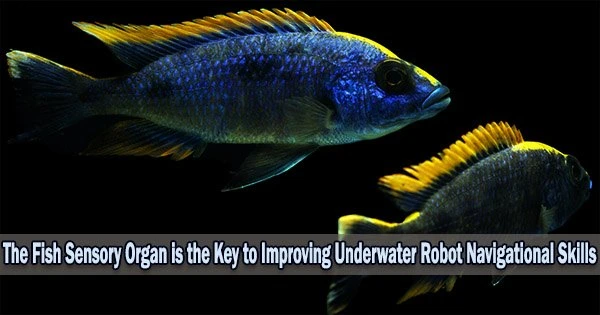Fish have specialized sensory organs, such as the lateral line and the electrosensory system, which enable them to navigate effectively in their underwater environment. By incorporating similar sensory organs into underwater robots, researchers aim to improve the navigational abilities of these robots and enable them to move more efficiently and effectively in underwater environments.
Researchers from the University of Bristol have been examining a fish’s sensory system to better understand signs for group behavior that might be applied to underwater robotics.
This research focused on the lateral line sensing organ, which is not only present in almost all fish species but also in African cichlid fish. This organ gives fish the ability to sense and interpret the water pressures around them with the acuity necessary to identify external factors like competing fish, changes in water flow, predators, and obstacles.
The fish’s head, trunk, and tail are all covered by the lateral line system as a whole. It is made up of mechanoreceptors (neuromasts) that are either located on the skin’s surface or in subdermal channels.
These findings provide a better understanding of how the lateral line informs shoaling behaviour in fish, while also contributing a novel design of inexpensive pressure sensor that could be useful on underwater robots that have to navigate in dark or murky environments.
Elliott Scott
Lead author Elliott Scott of the University of Bristol’s Department of Engineering Mathematics explained:
“We were attempting to find out if the different areas of the lateral line the lateral line on the head versus the lateral line on the body, or the different types of lateral line sensory units such as those on the skin, versus those under it, play different roles in how the fish is able to sense its environment through environmental pressure readings.”
“We did this in a novel way, by using hybrid fish, that allowed for the natural generation of variation.”
They found that the lateral line system around the head has the greatest impact on how well fish can swim in a shoal. Meanwhile, more neuromasts, which are lateral line sensory units, are found under the skin and tend to cause fish to swim closer together, whereas more neuromasts are found on the skin, which generally causes fish to swim further apart.
The researchers were able to demonstrate in modeling that the lateral line work’s underlying mechanisms apply not only to the microscopic scales present in genuine fish, but also to larger sizes. This may lead to the development of a unique class of inexpensive pressure sensor for use in swarm robotics, which is a sort of underwater robotics where cost is a major concern.
Elliott said: “These findings provide a better understanding of how the lateral line informs shoaling behaviour in fish, while also contributing a novel design of inexpensive pressure sensor that could be useful on underwater robots that have to navigate in dark or murky environments.”
The team now intends to improve the sensor and include it into a robotic platform to assist a robot in underwater navigation and show how successful it is.
Engineering and Physical Sciences Research Council (EPSRC), Biotechnology and Biological Sciences Research Council (BBSRC) and the Human Frontier Science Program (HFSP) funded the research for this paper.
















